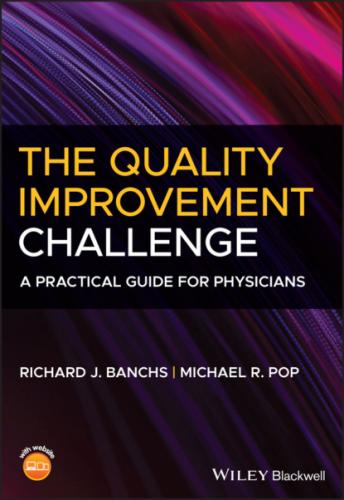The Quality Improvement Challenge. Richard J. Banchs
The problem you are trying to address and the process you are trying to fix will determine which customer you should consider. That is why clarity about the process’s start and end is so important. The process limits determine who you consider the customer and who are the stakeholders (the people that do the work).
Example: Supply Chain Management for Patient Care Units
Materials management receives the supplies that have been ordered from a vendor. If we consider the target the process “supply delivery to the hospital,” the vendor is the stakeholder, and materials management staff are the customers. Subsequently, patient care units’ supply rooms are restocked by materials management. Nurses use these supplies to restock carts in the hallways that are used by physicians on rounds. If the QI project aims to improve “the supply chain management for patient care units,” the customer is the nurse, and the suppliers are materials management staff. The carts are used by the physicians on rounds to provide wound care and re‐dress patient’s wounds. If the QI project aims to improve the “availability of supplies during rounds,” nurses become the suppliers, and physicians, the customers. This example illustrates the customer continuum, a chain with three “suppliers of service” and three customers receiving the output of the process. Depending on which portion of the process continuum (value stream) we focus on, the QI team changes and so do the boundaries and scope of the project.
| The supplier (professional providing a work product) | The customer (end user that receives a work product) |
| Vendor: Delivers ordered supplies to the hospital | Materials management: Receives ordered supplies |
| Materials management: Stocks patient care units’ supply room | Nurse: Finds the supplies needed in the supply room |
| Nurse: Restocks supply carts with wound dressing supplies | Physician: Finds needed supplies. Uses wound dressing supplies from supply cart to change patients’ dressings |
THE VOICE OF THE CUSTOMER (VOC)
What Is the “Voice of the Customer”?
A successful improvement project cannot be launched on the basis of our opinions, beliefs, or assumptions about the problem. It must be substantiated by a true assessment of the situation that includes a clear understanding of the nature of the problem from the perspective of the internal or external customer.
The Voice of the Customer (VOC) is the expression of the collective needs, wants, preferences, and expectations of the customers.
The first step in finding the “Right Problem” is to understand and define the problem from the perspective of the customer. The VOC uses the customer’s input to define the needs and requirements of the service or care that is being provided. As discussed previously, customers can be patients, providers, or staff. The VOC is critical to the project team because
It helps us understand the main drivers of quality and customer satisfaction.
It allow us to focus our improvement efforts.
It sets the priorities, scope, and goals for the project.
Quotable quote: “The first step in exceeding your patients’ expectations is to know those expectations.” Roy H. Williams
The “What” and “How” of the Voice of the Customer
Patients, providers, and staff are the customers of our healthcare processes. They expect an outcome (VOC). The outcome must have certain attributes and must be delivered within certain requirements. The VOC therefore has two distinct components (see Figure 8‐2):
1 The “what” (attributes). This is the needed outcome, and the attributes of the outcome the customer (patient, provider, or staff) expects. A patient expects an “effective treatment,” “clear instructions,” and “clean facilities.” Alternatively, when a physician is the customer of a process, he or she might expect an “accurate diagnosis,” a “centered chest X‐ray,” or the “correct demographic information.”
2 The “how” (requirements). These are the requirements that characterize the outcome (output). Patients expect care delivered “on‐time” or in a “culturally sensitive” manner. Physicians would expect a chest X‐ray (needed outcome) to show up in the EMR “in a timely fashion,” and the radiologist’s official reading to be “easily found in the EMR.”
FIGURE 8‐2 The outcome expected by the customer (VOC) is defined by attributes and requirements.
The customer (patient, staff, or provider) defines quality by identifying
the needed (expected) outcome.
the attributes of the outcome, and
the requirements that characterize the outcome.
Fulfilling the attributes (the “what”) and requirements (the “how”) of the VOC results in customer satisfaction. Achieving customers’ satisfaction is the ultimate goal of the QI project.
HOW DO WE COLLECT THE VOC?
Interviews
Interviews allow QI teams to get qualitative information about the needs and preferences of customers. Speaking to people that are the end users of the process and experience the problem can help us gain valuable information about the nature of the problem. It allows us to learn what the customer deems important and helps create a clear image about the customer’s needs and expectations. Interviews with the customers should be conducted at the beginning of the project to understand the issues. Interviews can also be conducted in the middle of a project to clarify important points, better understand the problem, or test potential ideas with the customers. Before conducting an interview, be clear about the what you are trying to achieve and the goal of the interview. Here are some steps you should take to maximize the return on investment of your interview.
Before the interview:
Select your customer’s segment carefully.
Decide on the criteria you are going to use for selecting interviewees.
Prepare a list of questions.
Decide on the interview method (face‐to‐face, phone, other).
Set an appropriate time and place.
During the interview:
Introduce yourself.
Clearly define the purpose of the interview.
Get consent if needed.
Listen carefully and take good notes.
Practice active listening.
Collect additional information about the customer if needed.
Thank
